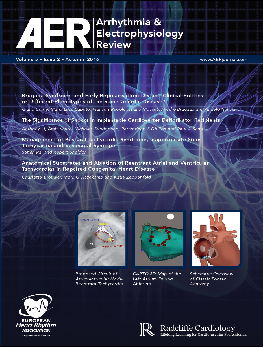AER - Volume 5 Issue 2 Autumn 2016
Welcome to the Autumn 2016 issue of Arrhythmia & Electrophysiology Review.
This issue commences with a foreword by Editor-in-Chief, Demosthenes Katritsis, highlighting the ongoing debate regarding the precise indications for implementation of cardiac resynchronisation therapy (CRT). Dr Katritsis comments: 'CRT is a valuable therapeutic mode, but cautious use is necessary to ensure its continuing efficiency in both medical and socio-economic terms.'
The clinical and electrophysiological overlap between Brugada syndrome and early repolarisation syndrome is discussed in a Clinical Review by Conte, Caputo, Regoli, Moccetti, Brugada and Auricchio, who go on to describe the complex interplay between genotype and phenotype in both conditions.
Li and colleagues examine the significance of shocks in implantable cardioverter defibrillator (ICD) recipients, while the role of antiarrhythmic drugs in avoiding unnecessary ICD shocks is reviewed by Abboud and Ehrlich.
Brouwer, Hazekamp and Zeppenfeld provide an update on the changing anatomical arrhythmogenic substrates and their potential impact on catheter ablation in patients with repaired congenital heart disease and tachyarrhythmias to round off this issue.
If you have comments on these or any of the other excellent clinical reviews included in this issue, or any suggestions for future issues of Arrhythmia & Electrophysiology Review, please let us know: managingeditor@radcliffecardiology.com









